
| February 2002 | ||||||
| Sun | Mon | Tue | Wed | Thu | Fri | Sat |
| 1 | 2 | |||||
| 3 | 4 | 5 | 6 | 7 | 8 | 9 |
| 10 | 11 | 12 | 13 | 14 | 15 | 16 |
| 17 | 18 | 19 | 20 | 21 | 22 | 23 |
| 24 | 25 | 26 | 27 | 28 | ||
Wednesday 06 February 2002
At 1200, EST the Training Ship Empire State was located 7 nautical miles south of Isla Beato, Dominican Republic, 17 degrees and 29 minutes North Latitude and 071 degrees 33 minutes West Longitude, steering course 300 degrees true at a speed of 4 knots/Rpm 20 turns. The weather was clear, winds from the east at 17 to 21 knots, air temperature was 81 degrees Fahrenheit, barometric pressure was 1018 millibars, seas were rough and from the east, sea injection temperature was 78 degrees Fahrenheit. Depth of water beneath the keel was 2000 meters.
CAPTAIN'S LOG
"No one is less ready for tomorrow than the person who holds the most rigid beliefs about what tomorrow will contain." Watts Wacker, Jim Taylor and Howard Means; The Visionary's Handbook
Today began as just another day at the office. I was up early to enjoy fresh pastry and the beautiful dawn. I was thinking about the water taxi ride from George Town and the relentless rust streaking the sides. The Empire State is a good old gal and she has been treating us well so far, but all this steel loves to revert to iron oxide. Whenever we anchor, I get out and ride around. Cadets hate that. I always return with a convincing work list and they know that it must be completed at the earliest opportunity. (Read next port) We worked on the hull in the Caymans, but there is always painting to do on a ship.
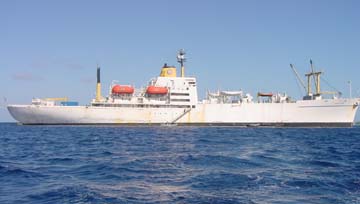
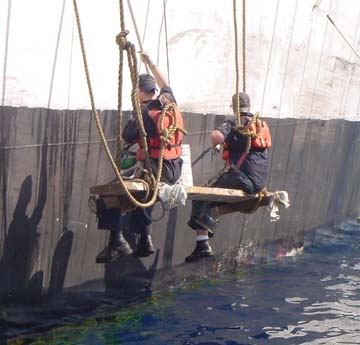
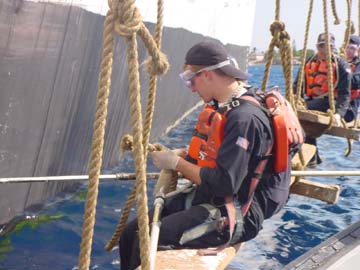
We were steaming just south of the Dominican Republic amid deteriorating sea conditions. I was almost finished documenting the maintenance pain when we passed a small sailboat at a range of three nautical miles. Now sailboats are common in these waters, but this one caused some concern. Last night I was awakened three times by the watch as a fiberglass mega-yacht maneuvered erratically around us. She was coping with the state 5 seas and force 6 winds apparently searching for an ideal course to make her passengers more comfortable. This, however, was a much smaller sailboat and was affected dramatically. About fifteen minutes after I spotted her, she called and requested assistance. She was unable to make headway, her sails were torn, she was low on fuel, and the skipper had gone more than 24 hours without sleep, and over 12 without food. He was alone and in my opinion, in distress.
We reversed course immediately, closed her position and soon discovered a full-keel (heavy) fiberglass sloop, languishing on the growing swells. Our experts assembled on the bridge and quickly assessed the situation. One mate tracked sea conditions and adjusted our course and speed; another watched the radar for approaching ships, while a third radioed the USCG in San Juan. The Chief Mate and his cadets prepared to launch small boats to recover the sailboat's skipper should that become necessary, while our expert sailors spoke with the skipper and assessed other conditions. I think that everyone on TSES was working the problem and we quickly decided to escort the vessel westward, 18 miles into the lee of Isla Beato, a point of land on the Dominican Republic. The skipper felt as if he could conn his boat for another five hours (I am not so confident) and he has been sailing a mere 100 feet off the port beam for the past three hours. He is riding well and is no longer alone; at least 100 cadets are standing at the rail shouting encouragement. When we reach calmer waters, I will put a boat in the water and send people to fix his bilge pump and replenish his fuel and water. The cooks will send fresh fruit, sandwiches, and Gatorade. Stay tuned. This is a breaking story and I will update you later.
Generally, the Sea Term plan puts theory and classroom lessons into practice. Events are closely scripted so that each division gets a similar experience and, although we try to make it look spontaneous, everyone knows it is training. This event, however, enables us to turn the tables somewhat. While rendering assistance to another vessel at sea is a very practical problem requiring ship handling expertise and teamwork, it is a study in real life and law too.
So why do we render assistance, anyway? You know the first and best answers; we are morally compelled to do so, we have empathy for other seaman, and professional ethics demand it. However, as with most things in our modern world, ethics and morals are heavily underscored by the legal system; such is required by law. The reference in this instance is Title 46, (Shipping) Chapter 23 (Operation of Vessels), of the United States Code. Cadets study the topic in Admiralty Law and are very well aware of the requirements. Section 2304 states that we are duty bound to provide assistance; "A master or individual in charge of a vessel shall render assistance to any individual found at sea in danger of being lost, so far as the master or individual in charge can do so without serious danger to the master's or individual's vessel or individuals on board."
This was a rare opportunity to do what is right and legal and the incident triggered new thought processes. We are comfortable operating independently but when one must divert his vessel to render assistance, other considerations quickly surface. Determining need for outside help is first and that information must be communicated to the United States Coast Guard, and others. This was not "scripted" communication and the watch section was understandably nervous about being correct. Then comes the issue of own ship's schedule and ETA next port. That is often the most significant consideration and with the speed of modern communications, this issue becomes more burdensome everyday. In the business world any delays can costs thousands of dollars and disrupt port schedules for several days. Berthing assignments are programmed like clock work; Tugs are of concern and agents must schedule fuel barges, cranes, and many other port services, almost to the minute. When one stops mid-ocean, the potential for monetary loss is huge but we have no choice. It is well that the Cadets learn that now rather than later.
"Life is what happens while you're making other plans."
CADET'S COMMENT
The Cayman Islands By 1/C Katelyn Ladden
The past couple of days were beautiful with temperatures in the 80's and not a cloud in the sky. I had not noticed how dark and murky the ocean off Massachusetts is until seeing Caribbean waters. The sea is pretty blue and you can see down to the bottom. When we were preparing to anchor in the Cayman Islands, the pilot instructed the Chief Mate, who was on the bow, to signal the bridge when he saw the bottom and we would drop the hook, imagine that.
The rates and first class cadets were pleasantly surprised when they were permitted to go ashore on Grand Cayman. When we anchor for training, swim call is the usual for cadets and only the staff officers and crew leave the ship. So, when the captain announced that we would go ashore, the Patriot's fans could not have been happier. Before the ship anchored, rumors were rampant about television signal quality at the anchorage but the fears were unfounded, the reception was just fine, and everyone enjoyed the game. Three motor whaleboats continuously operated between the ship and the dock. The sea taxis gave some of the underclassmen opportunities to get off the ship and to practice seamanship skills. Some of the cadets carried fishing rods on the boats and when there were no passengers, they would go fishing.
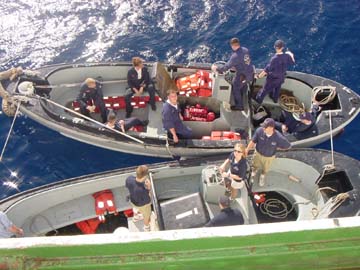
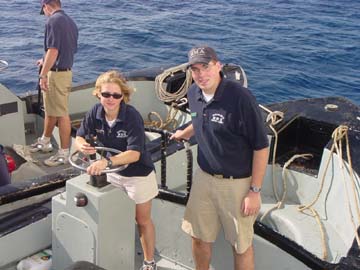
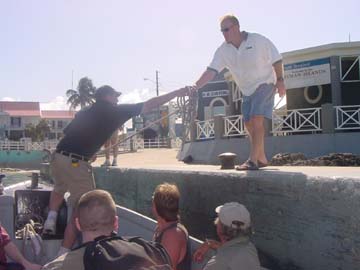
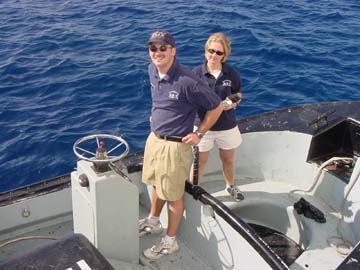
The beautiful Island is surrounded by coral reefs, and the beach sand is mostly finely grained coral. It was relaxing to get off the ship and lie on the beach all-day and swimming in the 80-degree water was very refreshing after being in the hot sun. The Island is mainly a tourist resort and it is very expensive. Cruise liners anchor early in the morning and depart by sunset, which leaves the passengers just enough time to shop and get a bite to eat. As we walked down Main street headed to the beach, many of the local people wanted to know where we were from and what kind of ship the Empire State was. They had never seen anything like it. They were very friendly and a local restaurant, called the Wreck, held a Superbowl party for us. They agreed to reduce their prices if more than 30 Maritimers came to watch the game. Of course, we had no problem getting those numbers and the party was on. The locals could not believe how excited we were. Between the hooting and hollering, one could just barely hear the game. When the Patriots made a good play, everyone would jump to their feet, yelling and slapping hi-fives. The owner of the restaurant took numerous pictures for his walls and to remember us by. By night's end, most cadets were voiceless but talk of the game continued throughout the following day. I doubt that Pats fans will ever stop talking about it. The Empire State left the Cayman Islands in the middle of the night Sunday, and we dock in Puerto Rico tomorrow.
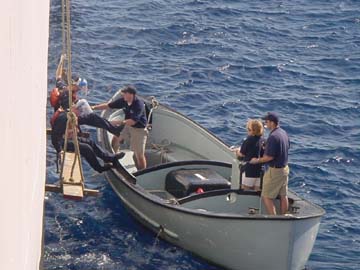
QUESTIONS FOR THURSDAY 07 FEBRUARY
MATH: The cadet on watch looked at the clock and saw that the time was exactly 1830 GMT. What is the measure of the angle between the hands of the clock? (1) 0 degrees (2) 15 degrees (3) 30 degrees (4) 24 degrees
SCIENCE: Sponges are benthic animals. What phylum are they classified? Where do benthic animals live?
GEOGRAPHY: The Caribbean is a warm and inviting tropical paradise. However, there are dangers as well. One of the most powerful, yet predictable dangers arrives during the summer season, lasting from June through October. Usually, no summer goes by without several visits to this region by this dangerous event. Sometimes the United States is also affected. What is the name of these dangerous and predictable occurrences?
HISTORY: You may have noticed that many islands in the Caribbean Sea now belong or have belonged to European nations. You also may be seeing that the United States has been, and is now, very interested in what happens in this valuable neighboring region. This was made very clear in 1823 when the United States issued a statement to the entire world that other countries were not welcome to interfere with countries in the New World (Western Hemisphere). It is one thing to say this; it is another to make it stick. What was the name of this very bold statement?
ANSWERS FOR WEDNESDAY 06 FEBRUARY
MATH: Convert inches to feet. 3/12 x 4/12 x 5/12 = 60 /1728 = 5/144
5/144 x 72 = 5/2 or
2.5 pounds.
SCIENCE: Order, and Species.
GEOGRAPHY: The deepest part of the Caribbean Sea is the Cayman Trench. It is 24,721 feet deep or 4.68 miles to the bottom.
HISTORY: In 1959, a revolution in Cuba brought a communist system to the island. The United States refuses to deal with the communist government of Cuba